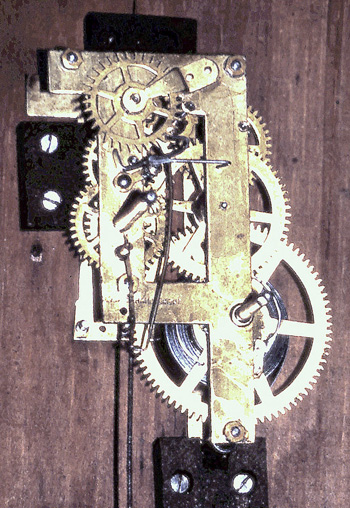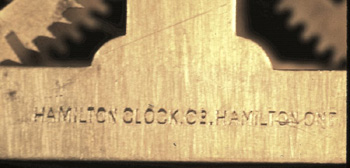The text and images below were provided by Canadian clocks expert Jim Connell. Jane Varkaris also did some of the original research for the book that they co-authored in 1986. The book details are given at the bottom of this section.
THE HAMILTON CLOCK COMPANY
Hamilton, Ontario (1876-1880)
History of the Company
This company was established in 1876, after the failure of the Canada Clock Company in Whitby, Ontario. The factory was located in an existing building at the corner of Cathcart and Kelly Streets in old Hamilton, Ontario.
The machinery and other tools and equipment were purchased and moved to Hamilton by two business men, James Simpson and George Lee. Simpson, born in Scotland, had been active in Hamilton for years as a partner in a wholesale grocery business. He assumed the title of President of the clock company. Lee, born in Ireland, was also active in food wholesaling, and the operation of hotels, and restaurants. He became the Business Manager. Neither man had any prior experience with factory operations or clock making.
Technical expertise was provided by John F. Collins, who had previously acted as Manager of the Canada Clock Company in Whitby and had been instrumental in equipping and operating that enterprise. He was brought from Whitby along with the equipment and given the title of Mechanical Superintendent.
Collins utilized tools, dies and designs he had created at Whitby, so the Hamilton company was really a continuation of his previous efforts. He was able to broaden the range of movements and case styles, and hence to offer a more complete line of merchandise. Unfortunately, after a few years, he appears to have fallen out with the new owners and left the company in 1879.
George Lee, in turn, suffered health problems and was obliged to leave around 1880.
This left James Simpson as sole proprietor. He ended production under the name Hamilton Clock Company and proceeded to make major changes. The factory and equipment were retained, but a completely updated product line was developed. Simpson found new investors and incorporated the firm as a public company that was renamed The Canada Clock Company Limited. Its history is covered in a separate of Gallery.
The Hamilton Clock Company appears to have made a valiant effort to provide clocks for the Canadian market, in competition with the huge U.S. clock factories in Connecticut that already dominated the market. Hamilton clocks matched competitive products in appearance and their quality was quite adequate. The volume achieved, however, was never very large and the product line was simple and limited.
No catalogues or printed material have ever been found from the company and our opinions can only be based on an examination of surviving clocks. Perhaps, like the attempt in Whitby, the available capital and ‘know-how’ were insufficient to ensure a major success.
Case Construction
Most mantel and wall clock cases from the Hamilton factory were made from standardized veneered mouldings that were cut and glued together in a variety of shapes. This technique was also used by competitive firms and certainly simplified the amount of woodworking skill required. To form the base of each case, two moulding styles were available, which can be described as “single curve” and “double curve”. The upper portion of each case was made from mouldings which were either “wide” or “narrow” in form.
The clock on the left is made from the “wide” moulding and “double curve” base.
On the right is an example with the “single curve base” and “narrow” moulding.
A wide variety of mantel clocks could then be made up, by varying style and color of mouldings as well as the size and shape of the final case. Further variety was achieved by using different dials, pendulums and glass tablets. Examples are shown in the illustrations at the bottom of this Gallery.
It should be mentioned that OG clocks were also manufactured at Hamilton, and these were identical in construction to those that had been made at Whitby with veneered pine cases. In addition, small cottage clocks were produced using plain stained pine or simple veneered pine. A few Hamilton clocks are also known that do not conform to these patterns. They may have been made for a special order or as a prototype for later production. See below for illustrations.
Movements Used in Hamilton Clock Company Clocks
Five different movements are known to have been produced at Hamilton during this period. These consisted of
- 30-hour, weight-driven, time & strike,
- 30-hour, spring-driven, time only,
- 30-hour, spring-driven, time & strike,
- 8-day, spring-driven, time & strike,
- a separate alarm mechanism
These movements are illustrated here, and further data can be obtained from the reference cited below. All are spring-driven except for the OG weight-driven movement. One variant, however, deserves special comment. The company offered an octagonal “schoolhouse style” wall clock for use in schools and offices, and it was usually sold with the 8-day striking movement.
Occasionally a customer would demand a clock that did not strike the hours. For the small number needed, it appears that funds were not diverted to produce a standard 8-day, time-only movement. To satisfy the customer, a regular 8-day striking movement was altered by physically cutting away the strike mechanism! This was a crude but practical solution, and a method seldom used by other manufacturers. The removed brass sections from the plates could be recycled.

30-hour, time & strike OG movement

30-hour, time-only, spring-driven movement

30-hour, spring-driven, time & strike movement

8-day, spring-driven, time & strike movement

8-day, time-only, spring-driven movement (strike side removed)

separate spring-driven alarm mechanism (bell not present)

company name stamp on brass movement plate
Labels on Hamilton Clock Company Clocks
Most clocks were fitted with standard labels that contained operating instructions, the company name, and location. The factory building was frequently shown in an engraving. Pictures of several examples are provided below. Model names were not given to most clocks. One exception was “The Simpson”, a simple little cottage clock of unusual shape, which is shown in the section below. It was, of course, named after the company President, James Simpson. Since only one example is known, it was apparently not a ‘best seller’.

OG clock label showing the three partners' names SIMPSON, LEE, and COLLINS

1-day mantel clock label

8-day mantel clock label

mantel clock with inside label

Simpson model clock label
Examples of Clocks Produced by the Hamilton Clock Company
This section shows examples of most of the clock varieties produced. Other variants may exist. In fact, new versions are identified from time to time. Some of the clocks shown are very rare and in some instances only one or two examples are known. Similar mantel clock styles are grouped together to show how the components could be varied within a single style to create new models. All had spring-driven pendulum movements, except the OG clocks.
OG WEIGHT-DRIVEN CLOCKS
The OG clock cases and movements are similar tothose made at Whitby. Labels may show the names of Simpson, Lee, and Collins, and later, Lee only. Note the etched glass tablets. Mirrors were also commonly used.
COTTAGE CLOCKS
This style was typically a small, time-only shelf clock that was less expensive to make and buy. Several American companies produced similar models in the mid/late 1800s.
Miniature with 30-hour, time-only movement
Standard size with 30-hour, time & alarm movement
POINTED-TOP MANTEL CLOCKS
Clocks in this style and the others shown below were also made by American companies at the same period of time (mid / late 1800s).
miniature 30-hour time

30-hour time & strike

30-hour time & strike

30-hour time & strike

30-hour time & strike

8-day time & strike
FLAT-TOP MANTEL CLOCKS
30-hour time & strike
FOUR-SIDED-TOP (“Octagon Prize”) MANTEL CLOCKS
miniature 30-hour, time-only
30-hour, time & strike
(note the beaver & maple leaves design on the glass tablet)

8-day, time & strike
8-day, time & strike
STEEPLE CLOCKS
miniature 30-hour, time-only
30-hour, time & strike
8-da,y time & strike
WALL CLOCKS
octagonal wall clock, time & strike
octagonal wall clock, time-only
SPECIAL MODELS
the Simpson mantel clock (30-hour, time-only)
carved case type 1, 8-day, time & strike
carved case type 2, 8-day, time & strike
gingerbread style case
The above clock was found as an empty case with label - the dial and movement were added for the photo.
Etched Glass Tablets
Many of the clocks shown above were fitted with glass tablets that contained acid-etched designs. These are unique. In the latter 1800s, Hamilton was the site of two glass-making plants, both of which made window glass. Glass decorating would have been commonplace at the time, and we do not know for sure if this was done at the clock factory or elsewhere.
In any event, no other clock maker, except the successor Canada Clock Co. Limited in Hamilton, offered so many designs of etched tablets. Many of them had religious motifs and others showed a variety of geometric patterns. They add a measure of charm to these otherwise rather plain clocks. Such tablets are rare on American-made clocks from the period.
For further reading see the following book:
The Canada and Hamilton Clock Companies, Jane Varkaris & James E. Connell,Boston Mills Press, Erin, Ontario 1986 (out of print).
NOTE: The museum's own clocks made by this company are included in a separate Gallery. TO BE ADDED MAY 2018. |